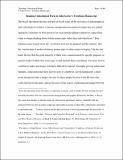| dc.contributor.author | Bahr, Arthur W. | |
| dc.date.accessioned | 2013-03-15T18:17:11Z | |
| dc.date.available | 2013-03-15T18:17:11Z | |
| dc.date.issued | 2011-01 | |
| dc.identifier.issn | 1949-0755 | |
| dc.identifier.issn | 0190-2407 | |
| dc.identifier.uri | http://hdl.handle.net/1721.1/77917 | |
| dc.description.abstract | In lieu of an abstract, here is a brief excerpt of the content:
The broad agreement that has emerged in recent years on the relevance of paleographical and codicological evidence to literary interpretation in medieval studies has not yielded analogous consensus on best practices for such interdisciplinary endeavors, particularly when we begin thinking about whole manuscripts rather than individual texts.1 This dilemma stems largely from the “oscillation between the planned and the random” that the construction of medieval literary manuscripts so often seems to display.2 On the one hand, the fact that the great majority of them were commissioned for specific purposes or patrons makes it likely that some logic would have animated their assemblage. Yet many factors, on the other, combine to make such logics extremely difficult to retrieve. Exemplar poverty rather than thematic connections may have led two texts to cohabit in a given manuscript; a short poem juxtaposed with a longer one may be there simply because it fits the space the scribe had left in the quire, and not because of the echoes of phrasing and image between the two. Literary scholars, trained to make arguments about thematic connections and formal echoes, are naturally inclined to see such ideational and aesthetic considerations at work rather than more mechanical ones, and this inescapable predisposition makes it both difficult and vital for us to grapple with the question of when it is legitimate to propose literary interpretations of manuscripts’ codicological features, using those features to support readings of texts they contain. | en_US |
| dc.language.iso | en_US | |
| dc.publisher | New Chaucer Society/Project MUSE | en_US |
| dc.relation.isversionof | http://dx.doi.org/10.1353/sac.2011.0025 | en_US |
| dc.rights | Creative Commons Attribution-Noncommercial-Share Alike 3.0 | en_US |
| dc.rights.uri | http://creativecommons.org/licenses/by-nc-sa/3.0/ | en_US |
| dc.source | Bahr via Mark Szarko | en_US |
| dc.title | Reading Codicological Form in John Gower’s Trentham Manuscript | en_US |
| dc.type | Article | en_US |
| dc.identifier.citation | Bahr, Arthur W. “Reading Codicological Form in John Gower’s Trentham Manuscript.” Studies in the Age of Chaucer 33.1 (2011): 219–262. CrossRef. Web. | en_US |
| dc.contributor.department | Massachusetts Institute of Technology. Department of Humanities. Literature Section | en_US |
| dc.contributor.approver | Bahr, Arthur | |
| dc.contributor.mitauthor | Bahr, Arthur W. | |
| dc.relation.journal | Studies in the Age of Chaucer | en_US |
| dc.eprint.version | Author's final manuscript | en_US |
| dc.type.uri | http://purl.org/eprint/type/JournalArticle | en_US |
| eprint.status | http://purl.org/eprint/status/PeerReviewed | en_US |
| dspace.orderedauthors | Bahr, Arthur W. | en |
| dc.identifier.orcid | https://orcid.org/0000-0003-3255-051X | |
| mit.license | OPEN_ACCESS_POLICY | en_US |
| mit.metadata.status | Complete | |
